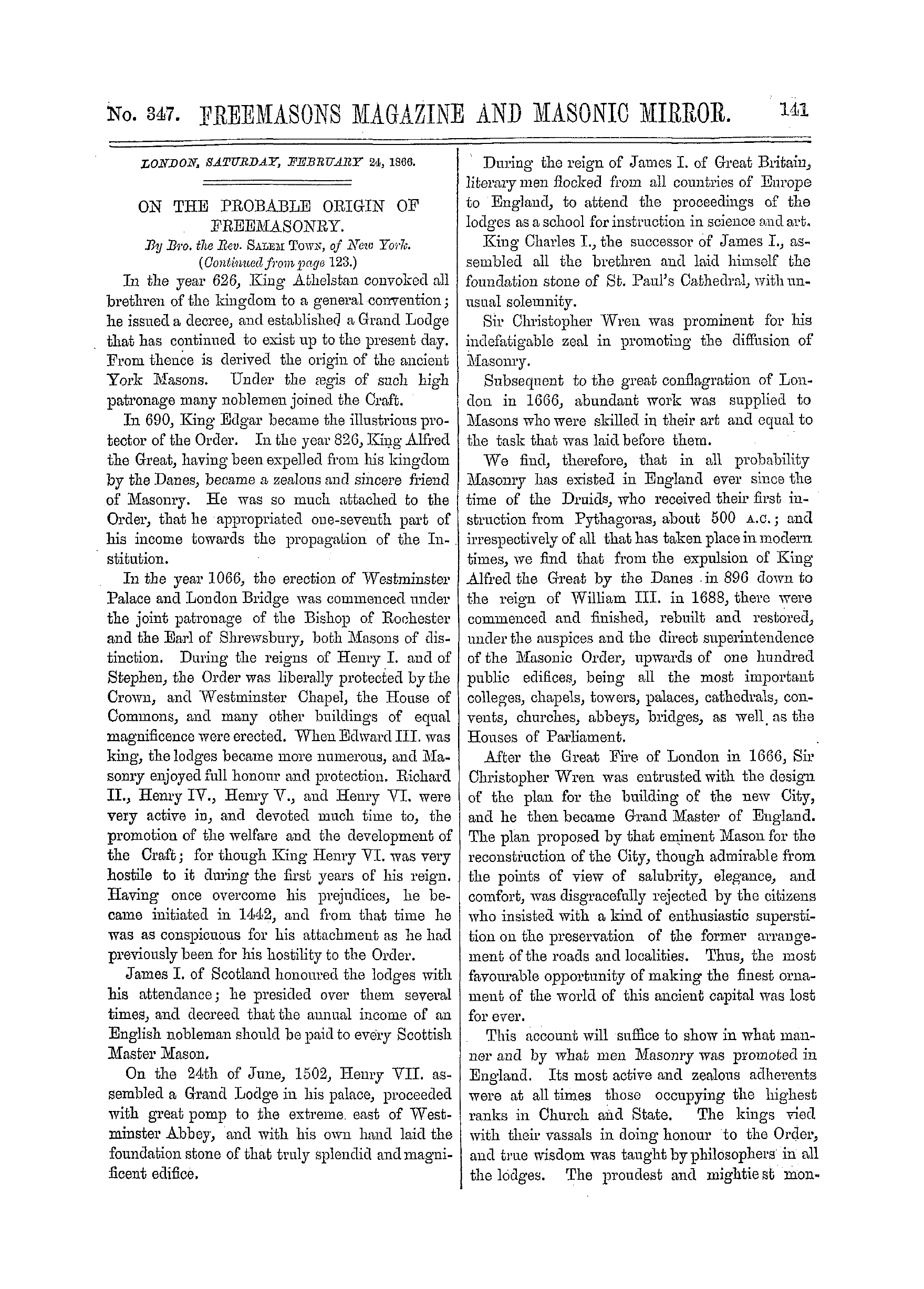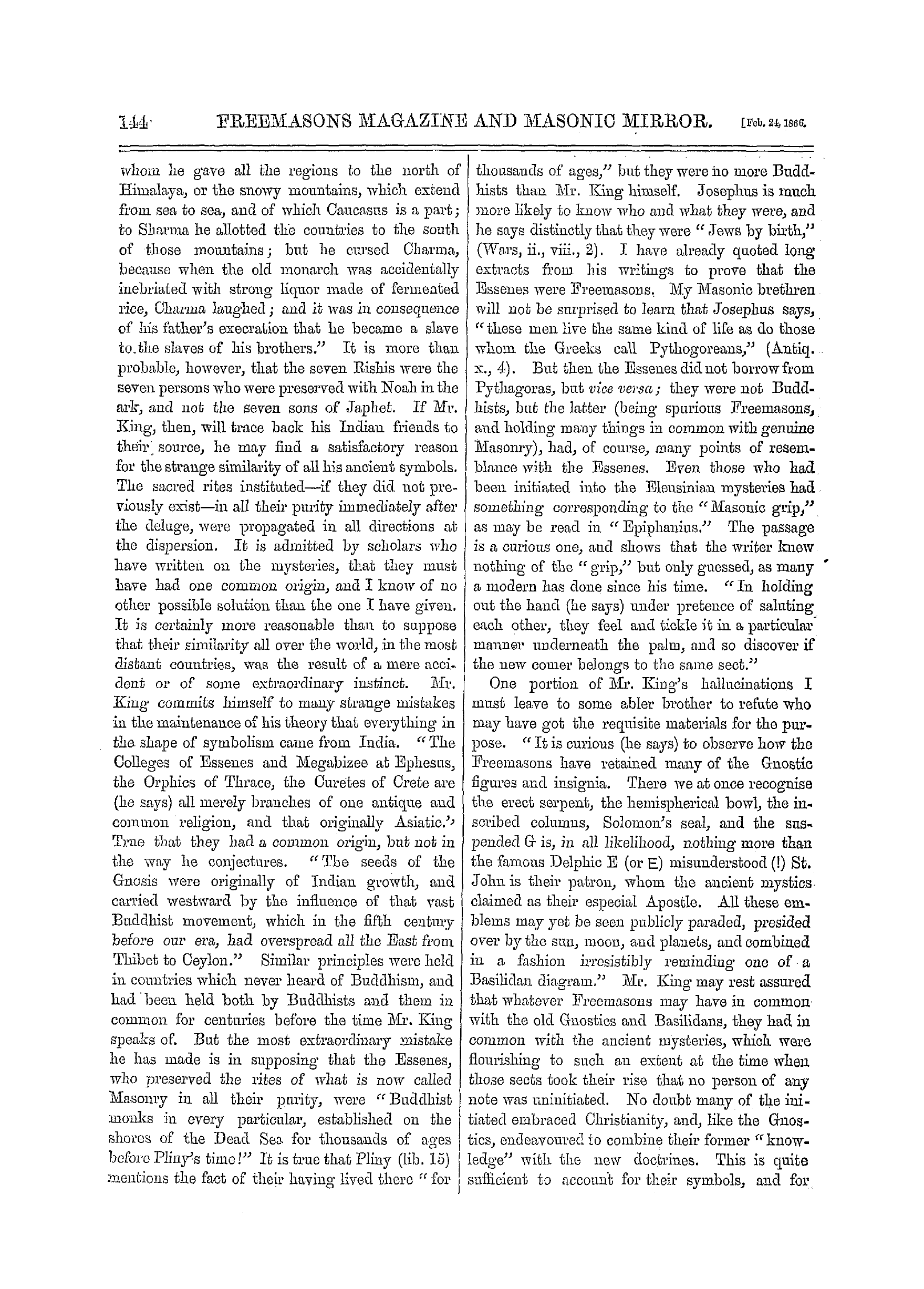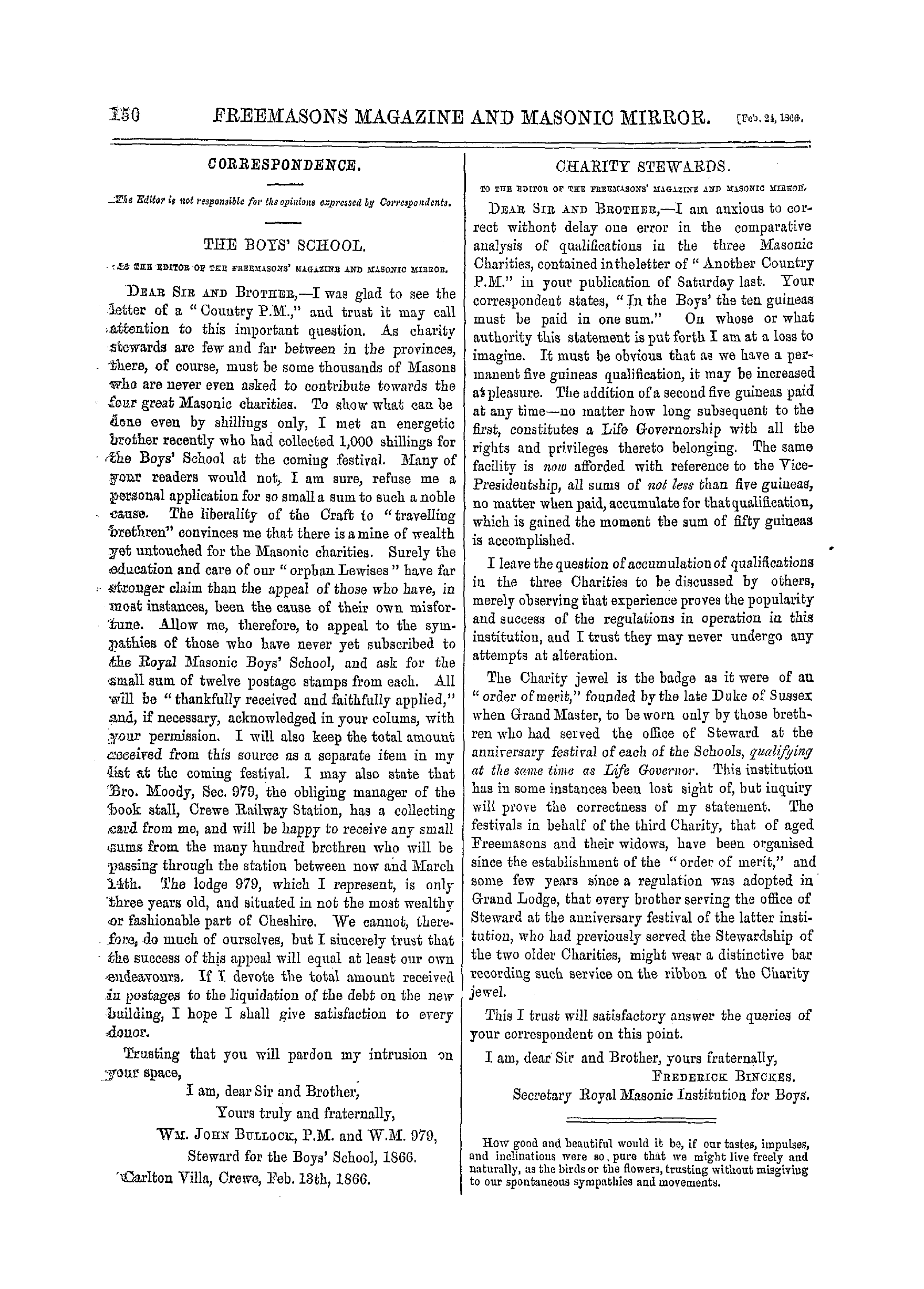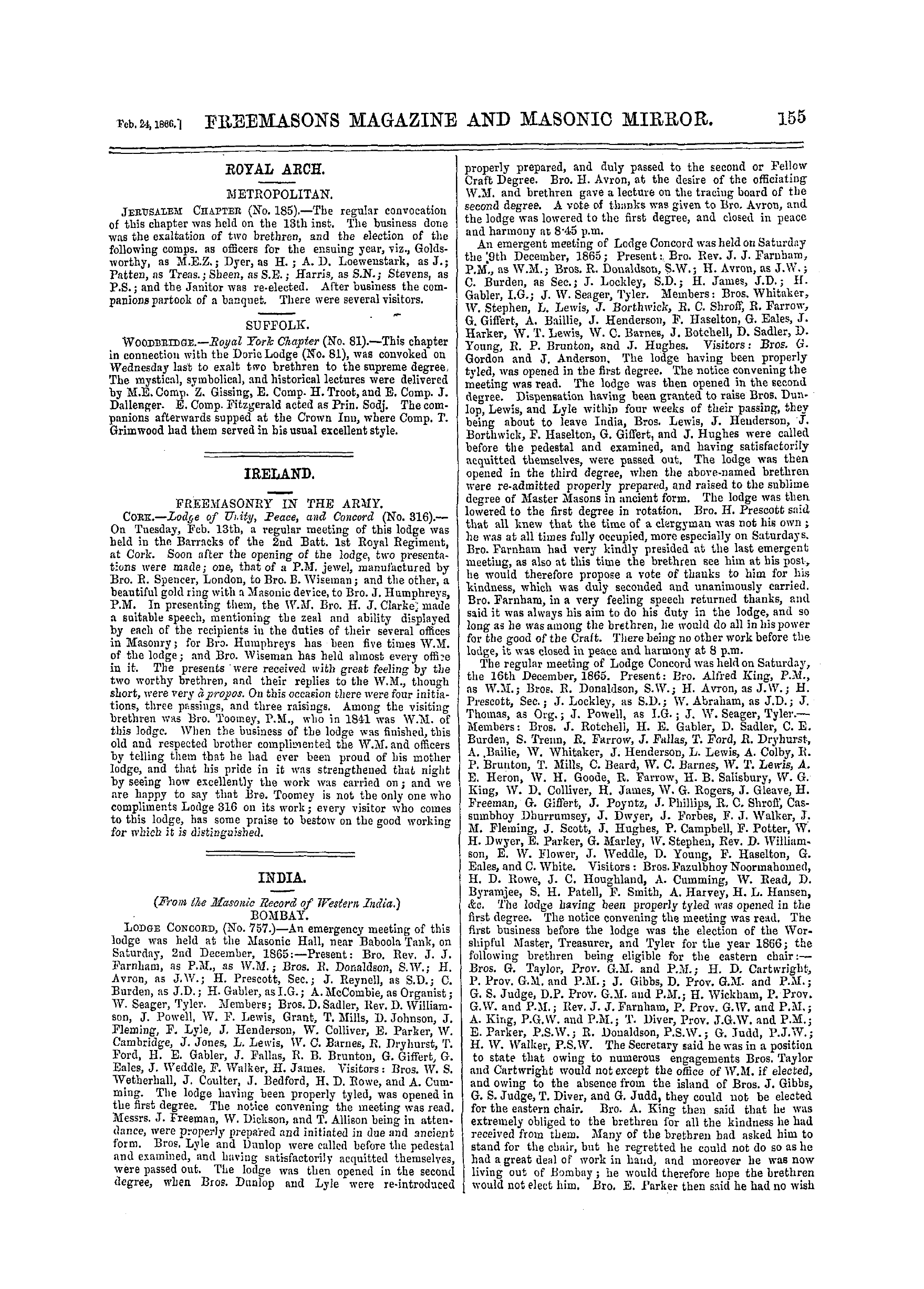-
Articles/Ads
Article THE POPE AND FREEMASONRY. ← Page 2 of 4 →
Note: This text has been automatically extracted via Optical Character Recognition (OCR) software.
The Pope And Freemasonry.
For most ordinary and unprejudiced readers it would be sufficient to ask , how , on Mr . King ' s hypothesis , we are to account for the singular fact that , if Freemasonry dates from the time of Sh * Christopher Wren , they contrived , without making
ludicrous mistakes , to hit upon marks and symbols used by any of those ancient heretics , seeing that in those days , with the exception of some of their peculiar doctrines , little ( if indeed , anything ) was known of the symbolism they had been in
the habit of adopting . The very supposition carries its own refutation with it . Had Mr . King known anything of Freemasonry—above all , that it was certainly older than Gnosticism—and had he on that account maintained that they had both
borrowed from some older source still , there would have been some sense in his idea . Amongst other illustrations he gives a set of regular Mason ' s marks , copied by Ouseley from the ashlar of the old Palace of Saaditalat , near Ispahan , in the
belief that they were the letters of an ancient , unknown language . He may see similar Mason ' s marks in Gloucester Cathedral , of the date A . D . 1089-1100 , in the nave , on the first Norman pillar from the west end on north side of nave , and in fact all over the interior of the Cathedral . Some
of these are identical with a set of Hindoo marks which he also gives . How can he account for the similarity—or rather identity—of Mason's marks in Gloucester and Ispahan , on the supposition that Masonry is very modern , and for the identity of
both with the very ancient Hindoo marks ? HOAV could Masons in England and Ispahan combine together to adopt the same distinguishing marks , and both hit upon those in use afc a most remote period of time ? Certainly not by accident .
It is quite amusing to seethe ridiculous mistakes made even by clever men who know nothing of Freemasonry , or of the ancient mysteries . Mr . Piazzi Smith , Astronomer of Scotland , went out to photograph the interior of the Great Pyramid .
He fancied thafc a certain coffin-shaped vessel in the middle chamber was the depository of the standard of measure of the Egyptians ! Freemasons know perfectly well that the Pyramids were merely spurious Masonic lodges , in which
aspirants were initiated into the mysteries . Even Mr . King , who could not possibly ignore the mysteries of Eleusis or Bacchus , seems fco be qnifce ignorant of the fact that not merely the primitive Indian Mystse—in his idea the parent society—but the followers of Odin in Scandinavia ,
the ancient Druids in England , and sifflflax r societies in all parts of the world , taught the susnep doctrines and used the same symbols . He traces ' everything connected with the symbolism of the '* Gnostics , of the followers of Basilides anc & oSieE
heretics , to the Brahmins and Buddhists of Indian Bufc where did the Buddhists get theirs- from ;? What more reasonable than to suppose that oill ( including the Indian ) were derived from one common source , dating back from a time when thst "
world was but thinly inhabited , and a general in > - tercourse was maintained between all the families : of the earth ? That common source is not difficult
to trace . Seeing that the ark was a symbolcommon to all the mysteries , and that the insrdents connected with the deluge were pronmlgate € & and taught in every one of these spurious lodges ^ , what more natural than to refer them to one
prii-mative , pure system in use on the plains of SM--nar before the dispersion took place ? WarbaitoB ? ( Divine Legation of Moses , vol . i ., p . 172 ) , says * * ,-. that " it was an universal opinion that the heathers mysteries were instituted pure . " As the peopfe
spread over the face of the earth , they took withx them the mysteries , but whilst retaining the lead--ing facts symbolised , they gradually perverted > them , till little more than the old symbols re > - mained . Yet , strange to say , without any assist- ,
ance from revelation , they continued to teach a >* trinity in unity , the immortality of the soul , ther promise of a Mediator , and a final state of rewards and punishments . The Druids of Engkmct . - in Caesar's time ( as I have before mentioned ) ,, be-
sides all this , taught that the world , having bees * once destroyed by a deluge , would next be destroyed by fire .
India—to which country Mr . King refers- a-B > the symbols—according to its own annals ^ was . derived from seven Rishis or penitents . "Who these were we can have little doubt after reading ' the following extract from the Indian Records .,
given by Maurice , "Hist . Hind . " vol . ii , p . 45 f " It is related in the Padma-Poorann that Satyavrata , whose miraculous preservation fromi a * general deluge is told at large in the Matsya , had * three sons , the eldest of whom was named Jyapeti-,, .
or Lord of the Earth ; the others were Cha ^ ma and Sharma ; which last words are in the valgaE dialects usually pronounced Cham and Sham ,, asr we frequently hear Kishn , for Chrishna , Thei royal Patriarch , for such is his character in the Pooraun , was particularly fond of Jyapeta ,. ta
Note: This text has been automatically extracted via Optical Character Recognition (OCR) software.
The Pope And Freemasonry.
For most ordinary and unprejudiced readers it would be sufficient to ask , how , on Mr . King ' s hypothesis , we are to account for the singular fact that , if Freemasonry dates from the time of Sh * Christopher Wren , they contrived , without making
ludicrous mistakes , to hit upon marks and symbols used by any of those ancient heretics , seeing that in those days , with the exception of some of their peculiar doctrines , little ( if indeed , anything ) was known of the symbolism they had been in
the habit of adopting . The very supposition carries its own refutation with it . Had Mr . King known anything of Freemasonry—above all , that it was certainly older than Gnosticism—and had he on that account maintained that they had both
borrowed from some older source still , there would have been some sense in his idea . Amongst other illustrations he gives a set of regular Mason ' s marks , copied by Ouseley from the ashlar of the old Palace of Saaditalat , near Ispahan , in the
belief that they were the letters of an ancient , unknown language . He may see similar Mason ' s marks in Gloucester Cathedral , of the date A . D . 1089-1100 , in the nave , on the first Norman pillar from the west end on north side of nave , and in fact all over the interior of the Cathedral . Some
of these are identical with a set of Hindoo marks which he also gives . How can he account for the similarity—or rather identity—of Mason's marks in Gloucester and Ispahan , on the supposition that Masonry is very modern , and for the identity of
both with the very ancient Hindoo marks ? HOAV could Masons in England and Ispahan combine together to adopt the same distinguishing marks , and both hit upon those in use afc a most remote period of time ? Certainly not by accident .
It is quite amusing to seethe ridiculous mistakes made even by clever men who know nothing of Freemasonry , or of the ancient mysteries . Mr . Piazzi Smith , Astronomer of Scotland , went out to photograph the interior of the Great Pyramid .
He fancied thafc a certain coffin-shaped vessel in the middle chamber was the depository of the standard of measure of the Egyptians ! Freemasons know perfectly well that the Pyramids were merely spurious Masonic lodges , in which
aspirants were initiated into the mysteries . Even Mr . King , who could not possibly ignore the mysteries of Eleusis or Bacchus , seems fco be qnifce ignorant of the fact that not merely the primitive Indian Mystse—in his idea the parent society—but the followers of Odin in Scandinavia ,
the ancient Druids in England , and sifflflax r societies in all parts of the world , taught the susnep doctrines and used the same symbols . He traces ' everything connected with the symbolism of the '* Gnostics , of the followers of Basilides anc & oSieE
heretics , to the Brahmins and Buddhists of Indian Bufc where did the Buddhists get theirs- from ;? What more reasonable than to suppose that oill ( including the Indian ) were derived from one common source , dating back from a time when thst "
world was but thinly inhabited , and a general in > - tercourse was maintained between all the families : of the earth ? That common source is not difficult
to trace . Seeing that the ark was a symbolcommon to all the mysteries , and that the insrdents connected with the deluge were pronmlgate € & and taught in every one of these spurious lodges ^ , what more natural than to refer them to one
prii-mative , pure system in use on the plains of SM--nar before the dispersion took place ? WarbaitoB ? ( Divine Legation of Moses , vol . i ., p . 172 ) , says * * ,-. that " it was an universal opinion that the heathers mysteries were instituted pure . " As the peopfe
spread over the face of the earth , they took withx them the mysteries , but whilst retaining the lead--ing facts symbolised , they gradually perverted > them , till little more than the old symbols re > - mained . Yet , strange to say , without any assist- ,
ance from revelation , they continued to teach a >* trinity in unity , the immortality of the soul , ther promise of a Mediator , and a final state of rewards and punishments . The Druids of Engkmct . - in Caesar's time ( as I have before mentioned ) ,, be-
sides all this , taught that the world , having bees * once destroyed by a deluge , would next be destroyed by fire .
India—to which country Mr . King refers- a-B > the symbols—according to its own annals ^ was . derived from seven Rishis or penitents . "Who these were we can have little doubt after reading ' the following extract from the Indian Records .,
given by Maurice , "Hist . Hind . " vol . ii , p . 45 f " It is related in the Padma-Poorann that Satyavrata , whose miraculous preservation fromi a * general deluge is told at large in the Matsya , had * three sons , the eldest of whom was named Jyapeti-,, .
or Lord of the Earth ; the others were Cha ^ ma and Sharma ; which last words are in the valgaE dialects usually pronounced Cham and Sham ,, asr we frequently hear Kishn , for Chrishna , Thei royal Patriarch , for such is his character in the Pooraun , was particularly fond of Jyapeta ,. ta



















